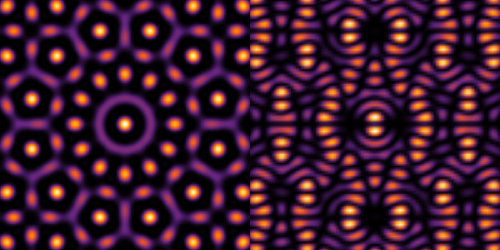Hidden Behavior of Quantum Quasicrystals
A quantum quasicrystal is a state of matter characterized by an ordered but nonrepeating arrangement of quantum particles. Such phases are predicted for a variety of systems and have been experimentally observed in ultracold atomic gases (see Viewpoint: A Quasicrystal for Quantum Simulations). However, little has been known about the low-energy excitations of quantum quasicrystals. Now Alejandro Mendoza-Coto at the Federal University of Santa Catarina in Brazil and his colleagues present a theory that sheds light on these excitations [1]. Thanks to its generality, the theory could also be applied to other systems, including bosonic supersolids.
The researchers considered a two-dimensional gas of bosons at zero temperature, with the particles interacting through an isotropic, long-range two-body interaction. When the density of bosons is sufficiently high, this system forms a quantum quasicrystal that typically adopts an octagonal, decagonal, or dodecagonal structure. The behavior of the quasicrystal is driven by the interplay of three types of excitation: phonons (structural vibrations), phasons (structural rearrangements), and condensate sound waves. The new theory, which the team constructed from first principles, describes this interplay.
The theory predicts that the quasicrystal can exhibit five types of collective behavior, called excitation modes, and estimates the velocities of their associated quasiparticles. For the octagonal structure, each mode has longitudinal and transverse components and an anisotropic speed. By contrast, for the decagonal and dodecagonal structures, three modes are longitudinal, while two are transverse, and each mode has an isotropic speed. These predictions could be experimentally verified using ultracold atomic gases, the researchers say.
–Ryan Wilkinson
Ryan Wilkinson is a Corresponding Editor for Physics Magazine based in Durham, UK.
References
- A. Mendoza-Coto et al., “Low-energy excitations in bosonic quantum quasicrystals,” Phys. Rev. Lett. 134, 136003 (2025).




